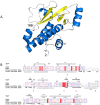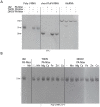Comparative structural and functional analysis of orthomyxovirus polymerase cap-snatching domains
- PMID: 24454773
- PMCID: PMC3893164
- DOI: 10.1371/journal.pone.0084973
Comparative structural and functional analysis of orthomyxovirus polymerase cap-snatching domains
Abstract
Orthomyxovirus Influenza A virus (IAV) heterotrimeric polymerase performs transcription of viral mRNAs by cap-snatching, which involves generation of capped primers by host pre-mRNA binding via the PB2 subunit cap-binding site and cleavage 10-13 nucleotides from the 5' cap by the PA subunit endonuclease. Thogotoviruses, tick-borne orthomyxoviruses that includes Thogoto (THOV), Dhori (DHOV) and Jos (JOSV) viruses, are thought to perform cap-snatching by cleaving directly after the cap and thus have no heterogeneous, host-derived sequences at the 5' extremity of their mRNAs. Based on recent work identifying the cap-binding and endonuclease domains in IAV polymerase, we determined the crystal structures of two THOV PB2 domains, the putative cap-binding and the so-called '627-domain', and the structures of the putative endonuclease domains (PA-Nter) of THOV and DHOV. Despite low sequence similarity, corresponding domains have the same fold confirming the overall architectural similarity of orthomyxovirus polymerases. However the putative Thogotovirus cap-snatching domains in PA and PB2 have non-conservative substitutions of key active site residues. Biochemical analysis confirms that, unlike the IAV domains, the THOV and DHOV PA-Nter domains do not bind divalent cations and have no endonuclease activity and the THOV central PB2 domain does not bind cap analogues. On the other hand, sequence analysis suggests that other, non-influenza, orthomyxoviruses, such as salmon anemia virus (isavirus) and Quaranfil virus likely conserve active cap-snatching domains correlating with the reported occurrence of heterogeneous, host-derived sequences at the 5' end of the mRNAs of these viruses. These results highlight the unusual nature of transcription initiation by Thogotoviruses.
Conflict of interest statement
Figures






Similar articles
-
Bunyaviridae RNA polymerases (L-protein) have an N-terminal, influenza-like endonuclease domain, essential for viral cap-dependent transcription.PLoS Pathog. 2010 Sep 16;6(9):e1001101. doi: 10.1371/journal.ppat.1001101. PLoS Pathog. 2010. PMID: 20862319 Free PMC article.
-
Nucleoprotein viral RNA and mRNA of Thogoto virus: a novel "cap-stealing" mechanism in tick-borne orthomyxoviruses?J Virol. 1996 Dec;70(12):8361-7. doi: 10.1128/JVI.70.12.8361-8367.1996. J Virol. 1996. PMID: 8970956 Free PMC article.
-
In vitro polymerase activity of Thogoto virus: evidence for a unique cap-snatching mechanism in a tick-borne orthomyxovirus.J Virol. 1997 Nov;71(11):8347-51. doi: 10.1128/JVI.71.11.8347-8351.1997. J Virol. 1997. PMID: 9343188 Free PMC article.
-
The Cap-Snatching Mechanism of Bunyaviruses.Trends Microbiol. 2020 Apr;28(4):293-303. doi: 10.1016/j.tim.2019.12.006. Epub 2020 Jan 13. Trends Microbiol. 2020. PMID: 31948728 Review.
-
Interplay between Influenza Virus and the Host RNA Polymerase II Transcriptional Machinery.Trends Microbiol. 2019 May;27(5):398-407. doi: 10.1016/j.tim.2018.12.013. Epub 2019 Jan 11. Trends Microbiol. 2019. PMID: 30642766 Free PMC article. Review.
Cited by
-
ANP32 proteins from ticks and vertebrates are key host factors for replication of Bourbon virus across species.J Virol. 2025 Jun 17;99(6):e0052225. doi: 10.1128/jvi.00522-25. Epub 2025 May 14. J Virol. 2025. PMID: 40366164 Free PMC article.
-
Comprehensive Review of Emergence and Virology of Tickborne Bourbon Virus in the United States.Emerg Infect Dis. 2023 Jan;29(1):1-7. doi: 10.3201/eid2901.212295. Emerg Infect Dis. 2023. PMID: 36573641 Free PMC article. Review.
-
Cryo-EM structures of Thogoto virus polymerase reveal unique RNA transcription and replication mechanisms among orthomyxoviruses.Nat Commun. 2024 May 30;15(1):4620. doi: 10.1038/s41467-024-48848-3. Nat Commun. 2024. PMID: 38816392 Free PMC article.
-
Conformational changes in Lassa virus L protein associated with promoter binding and RNA synthesis activity.Nat Commun. 2021 Dec 2;12(1):7018. doi: 10.1038/s41467-021-27305-5. Nat Commun. 2021. PMID: 34857749 Free PMC article.
-
Transcription and replication mechanisms of Bunyaviridae and Arenaviridae L proteins.Virus Res. 2017 Apr 15;234:118-134. doi: 10.1016/j.virusres.2017.01.018. Epub 2017 Jan 27. Virus Res. 2017. PMID: 28137457 Free PMC article. Review.
References
-
- Kawaoka Y, Palese P (2005) Family Orthomyxoviridae. In: Fauquet CM, Mayo MA, Maniloff J, Desselberger U, Ball L, editors. Virus Taxonomy: Eighth Report of the International Committee on Taxonomy of Viruses,. San Diego: Elsevier Academic Press. pp. 681–693.
-
- Haig DA, Woodall JP, Danskin D (1965) Thogoto Virus: A Hitherto Underscribed Agent Isolated from Ticks in Kenya. Journal of general microbiology 38: 389–394. - PubMed
-
- Anderson CR, Casals J (1973) Dhori virus, a new agent isolated from Hyalomma dromedarii in India. The Indian journal of medical research 61: 1416–1420. - PubMed
-
- Moore DL, Causey OR, Carey DE, Reddy S, Cooke AR, et al. (1975) Arthropod-borne viral infections of man in Nigeria, 1964–1970. Ann Trop Med Parasitol 69: 49–64. - PubMed
Publication types
MeSH terms
Substances
LinkOut - more resources
Full Text Sources
Other Literature Sources
Miscellaneous

